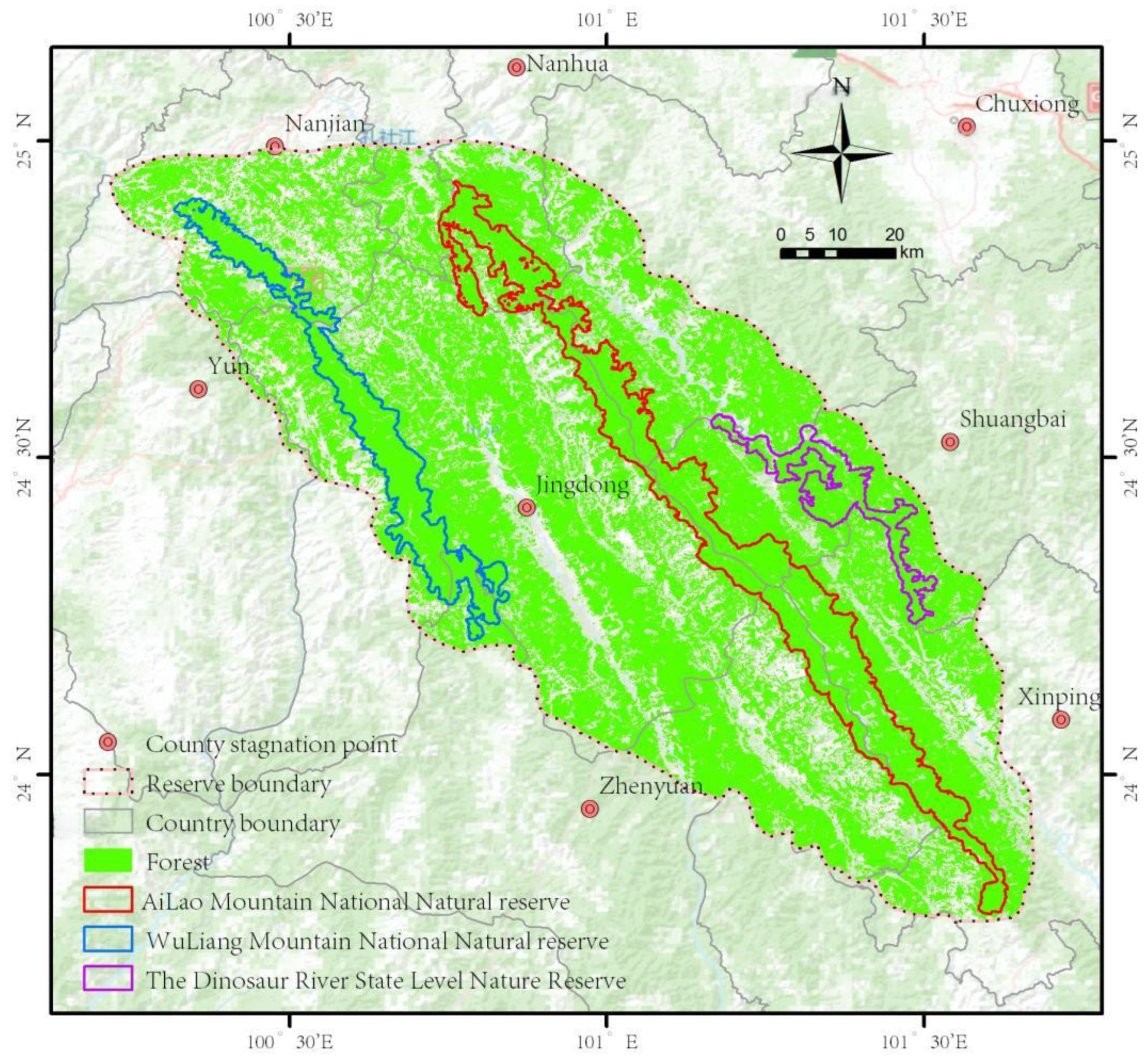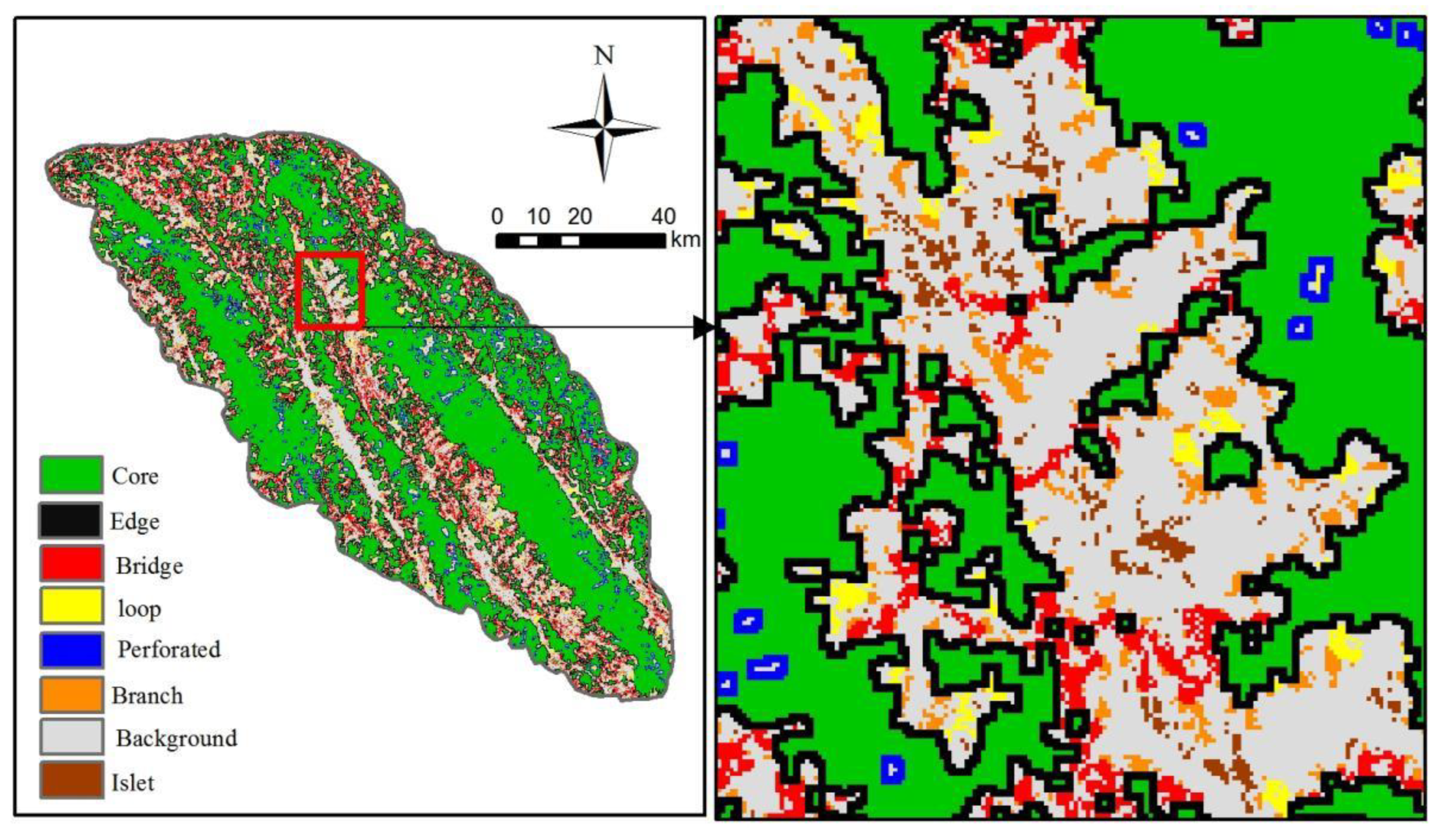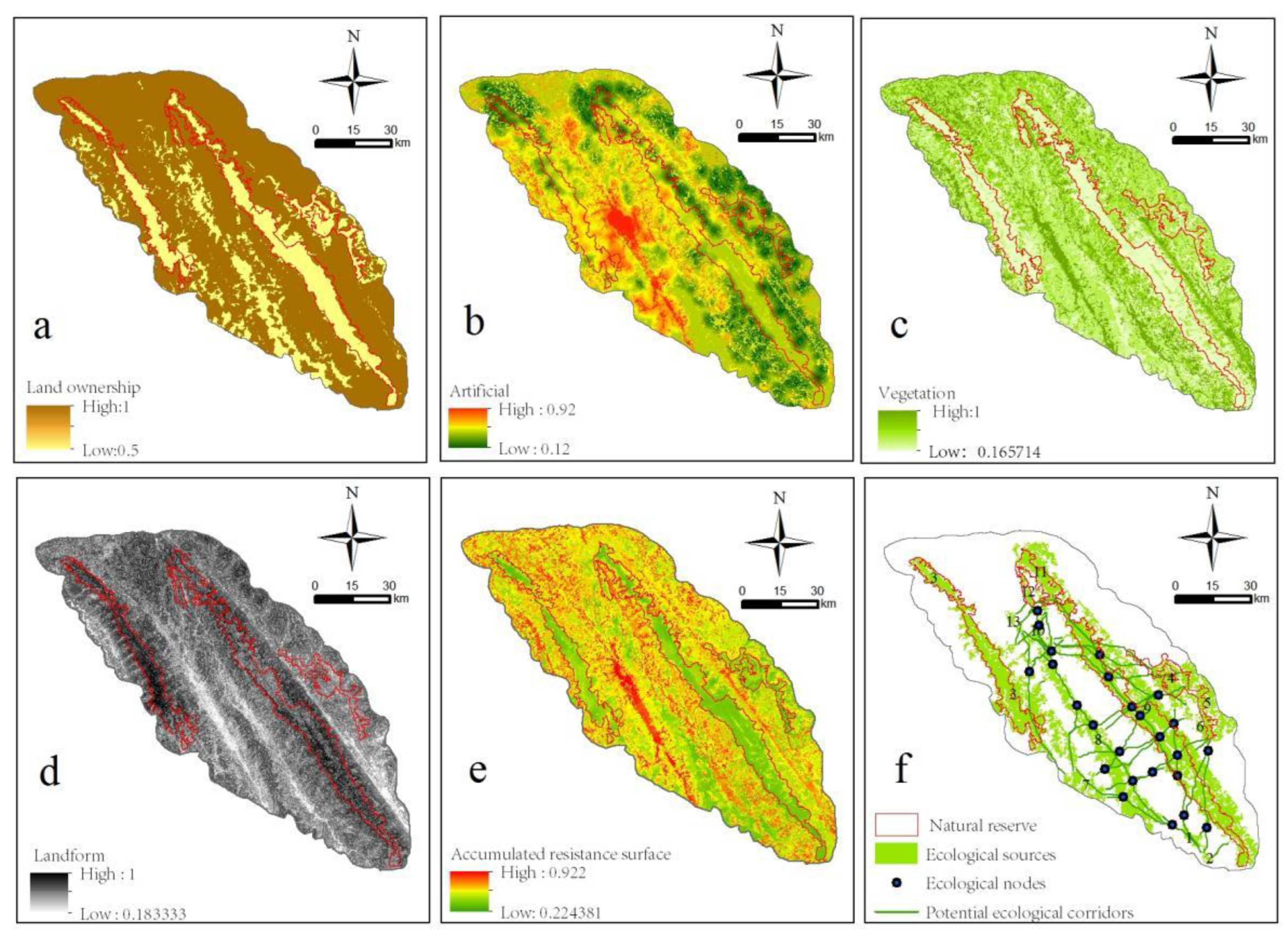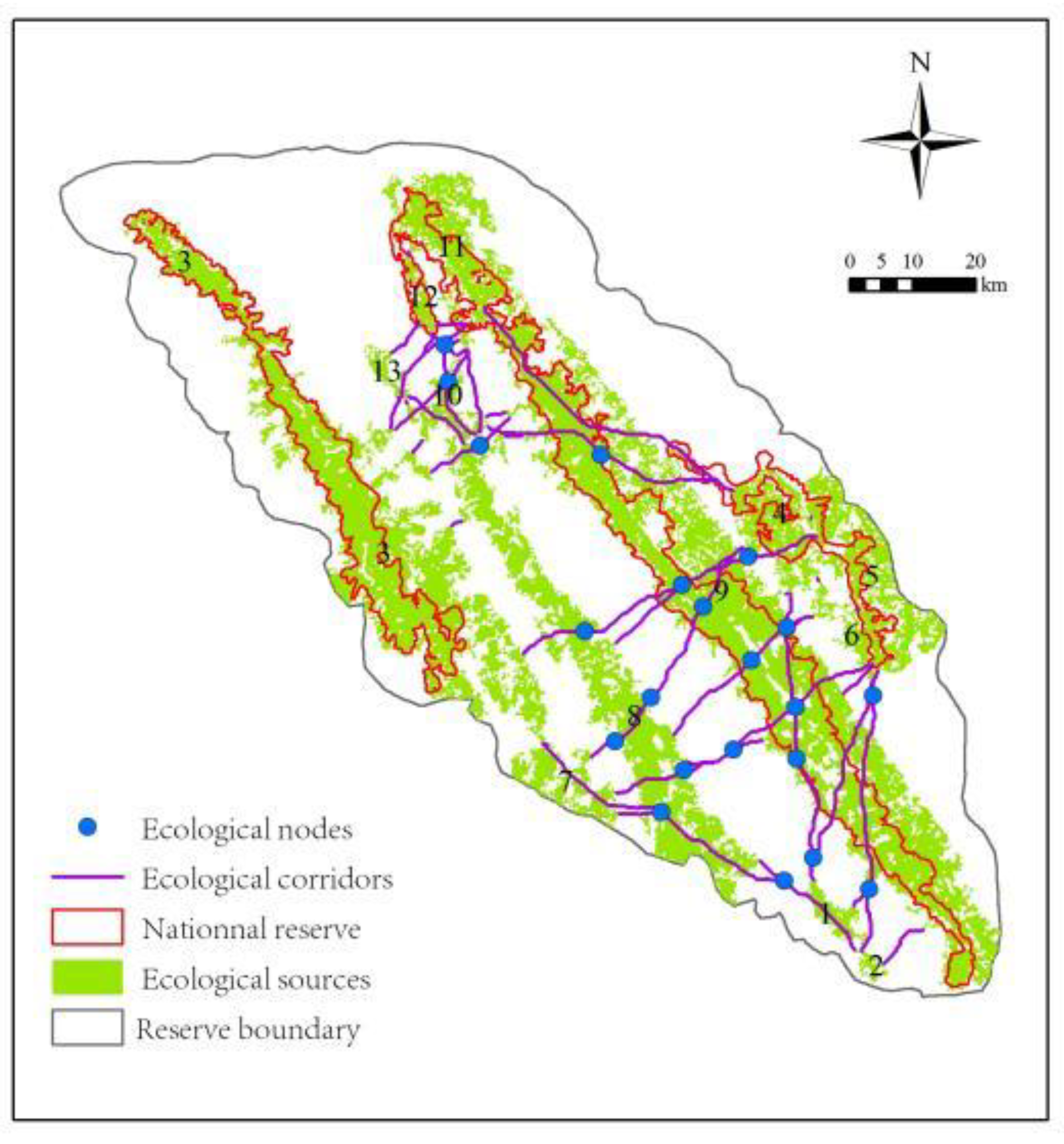Ecological Network Construction of a National Park Based on MSPA and MCR Models: An Example of the Proposed National Parks of “Ailaoshan-Wuliangshan” in China
Abstract
:1. Introduction
2. Materials and Methods
2.1. Study Area
2.2. Data Sources and Preprocessing
2.3. Methods
2.3.1. Identifying Ecological Sources Based on MSPA
2.3.2. Evaluating the Importance of Ecologically Sourced Landscapes
2.3.3. Ecological Network Construction Method
- Construction of Integrated Resistance Surface
- 2.
- Potential ecological corridor construction based on the MCR model
- 3.
- Determination of the ecological nodes
- 4.
- Identify important ecological corridors
2.3.4. Ecological Network Connectivity Evaluation
3. Results and Analysis
3.1. Subsection Analysis of Ecological Source Results Based on MSPA
3.2. Analysis of the Importance of Ecological Source Landscapes
3.3. Ecological Network Construction
3.3.1. MCR Based on the Analysis of Potential Ecological Corridor Extraction
3.3.2. Important Analysis of Ecological Corridors
3.3.3. Analysis of Ecological Corridor Construction in Nature Reserves
3.3.4. Ecological Network Connectivity Evaluation
4. Discussion
4.1. Advantages and Challenges of Research Methods Based on MSPA and MCR Models
4.2. Proposed Construction of the Ecological Network of Ailaoshan-Wuliang Mountain National Park
4.3. The Impact of Building Ecological Networks on Surrounding Land
5. Conclusions
Author Contributions
Funding
Data Availability Statement
Acknowledgments
Conflicts of Interest
References
- Cai, J.; Yu, W.B.; Zhang, T.; Wang, H.; Li, D.Z. China’s biodiversity hotspots revisited: A treasure chest for plants. Phyto Keys 2019, 130, 1–24. [Google Scholar] [CrossRef] [PubMed] [Green Version]
- Di-Qiang, L.; Yan-Ling, S. Review on hot spot and GAP analysis. Biodivers. Sci. 2000, 8, 208–214. [Google Scholar] [CrossRef]
- Cook, E.A. Urban landscape networks: An ecological planning framework. Landsc. Res. 1991, 16, 7–15. [Google Scholar] [CrossRef]
- The General Office of the CPC Central Committee The General Office of the State Council issued the Guiding Opinions on Establishing a Protected Natural Areas System with National Parks as the main body. Bull. State Counc. People’s Repub. China 2019, 19, 16–21.
- Yang, Y.; Zhu, Y. China has officially established the first batch of national parks. Eco-Econ. 2021, 37, 9–12. [Google Scholar]
- Zhang, D.; Xia, E.; Liu, C.; Yang, W.; Ma, Y.; Fan, S. The origin and innovation of China’s National Park concept. World For. Res. 2022, 35, 1–7. [Google Scholar] [CrossRef]
- Tang, X.; Luan, X. Build a protected natural area system with national parks as the main body. For. Resour. Manag. 2017, 6, 1–8. [Google Scholar] [CrossRef]
- Wang, W.; Li, J. Development course of biodiversity conservation Policy in China. Environ. Sustain. Dev. 2021, 4 6, 26–33. [Google Scholar] [CrossRef]
- Convention on Biological Diversity. Aichi Biodiversity Targets. 2010. Available online: https://www.cbd.int/sp/targets/ (accessed on 1 October 2022).
- Secretariat, C.B.D. First Draft of the Post-2020 Global Biodiversity Framework. 2021. Available online: https://www.cbd.int/doc/c/abb5/591f/2e46096d3f0330b08ce87a45/wg2020-03-03-en.pdf (accessed on 1 October 2022).
- Luo, Y.; Wu, J.; Wang, X.; Wang, Z.; Zhao, Y. Can policy maintain habitat connectivity under landscape fragmentation? A case study of Shenzhen, China. Sci. Total Environ. 2020, 715, 136829. [Google Scholar] [CrossRef]
- Yang, L.; Suo, M.; Gao, S.; Jiao, H. Construction of an Ecological Network Based on an Integrated Approach and Circuit Theory: A Case Study of Panzhou in Guizhou Province. Sustainability 2022, 14, 9136. [Google Scholar] [CrossRef]
- Liu, H.; Niu, T.; Yu, Q.; Yang, L.; Ma, J.; Qiu, S. Evaluation of the Spatiotemporal Evolution of China’s Ecological Spatial Network Function–Structure and Its Pattern Optimization. Remote Sens. 2022, 14, 4593. [Google Scholar] [CrossRef]
- Weber, T.; Sloan, A.; Wolf, J. Maryland’s Green Infrastructure Assessment: Development of a comprehensive approach to land conservation. Landsc. Urban Plan. 2006, 77, 94–110. [Google Scholar] [CrossRef]
- Chen, Z.; Kuang, D.; Wei, X.; Zhang, L. Construction of Yujiang County Ecological network based on MSPA and MCR model. Yangtze River Basin Resour. Environ. 2017, 26, 1199–1207. [Google Scholar]
- Soille, P. Morphological Image Analysis: Principles and Applications; Springer: Berlin/Heidelberg, Germany, 1999. [Google Scholar] [CrossRef] [Green Version]
- Sudhakar Reddy, C.; Vazeed Pasha, S.; Satish, K.V.; Saranya, K.R.L.; Jha, C.S.; Krishna Murthy, Y.V.N. Quantifying nationwide land cover and historical changes in forests of Nepal (1930–2014): Implications on forest fragmentation. Biodivers. Conserv. 2018, 27, 91–107. [Google Scholar] [CrossRef]
- Huang, X.Y.; Ye, Y.H.; Zhang, Z.Y.; Ye, J.X.; Gao, J.; Bogonovich, M.; Zhang, X. A township-level assessment of forest fragmentation using morphological spatial pattern analysis in Qujing, Yunnan Province, China. J. Mt. Sci. 2021, 18, 3125–3137. [Google Scholar] [CrossRef]
- Shi, Y. Research on Ecological Network Construction in Zixing City Based on MSPA and MCR Models. Master’s Thesis, Central South University of Forestry and Technology, Changsha, China, 2019. [Google Scholar]
- Chen, N.; Kang, S.; Zhao, Y.; Zhou, Y.; Yan, J.; Lu, Y. Construction of the Qinling Mountains (Shaanxi section) mountain ecological network based on MSPA and MCR models. J. Appl. Ecol. 2021, 32, 1545–1553. [Google Scholar] [CrossRef]
- Zhou, D.; Song, W. Identifying ecological corridors and networks in mountainous areas. Int. J. Environ. Res. Public Health 2021, 18, 4797. [Google Scholar] [CrossRef]
- Chen, C.D.; Wu, S.J.; Meurk, C.D.; Lu, M.Q.; Wen, Z.F.; Jiang, Y.; Chen, J.L. Impact of resistance assignment on landscape connectivity simulation. J. Ecol. 2015, 35, 7367–7376. [Google Scholar]
- Allen, C.H.; Parrott, L.; Kyle, C. An individual-based modelling approach to estimate landscape connectivity for bighorn sheep (Ovis canadensis). Peer J 2016, 4, e2001. [Google Scholar] [CrossRef] [Green Version]
- Saura, S.; Pascual-Hortal, L. A new habitat availability index to integrate connectivity in landscape conservation planning: Comparison with existing indices and application to a case study. Landsc. Urban Plan. 2007, 83, 91–103. [Google Scholar] [CrossRef]
- Yin, Y.; Liu, S.; Sun, Y.; Zhao, S.; An, Y.; Dong, S.; Coxixo, A. Identifying multispecies dispersal corridor priorities based on circuit theory: A case study in Xishuangbanna, Southwest China. J. Geogr. Sci. 2019, 29, 1228–1245. [Google Scholar] [CrossRef]
- Knaapen, J.P.; Scheffer, M.; Harms, B. Estimating habitat isolation in landscape planning. Landsc. Urban Plan. 1992, 23, 1–16. [Google Scholar] [CrossRef]
- Huang, L.; Chen, J. Evaluation of urban construction land in Huadu District, Guangzhou—Based on MCR surface feature extraction. Resour. Sci. 2014, 36, 1347–1355. [Google Scholar]
- Li, F.; Ye, Y.; Song, B.; Wang, R. Evaluation of urban suitable ecological land based on the minimum cumulative resistance model: A case study from Changzhou, China. Ecol. Model. 2015, 318, 194–203. [Google Scholar] [CrossRef]
- Ye, H.; Yang, Z.; Xu, X. Ecological corridors analysis based on MSPA and MCR model—A case study of the Tomur World Natural Heritage Region. Sustainability 2020, 12, 959. [Google Scholar] [CrossRef] [Green Version]
- Luo, Y.; Tan, X.; He, L.; Li, C. Construction and optimization of ecological network in Qionglai Mountain-Daxiangling area of Giant Panda National Park. Landsc. Archit. 2022, 29, 93–101. [Google Scholar] [CrossRef]
- Zhao, S.M.; Ma, Y.F.; Wang, J.L.; You, X.Y. Landscape pattern analysis and ecological network planning of Tianjin City. Urban For. Urban Green. 2019, 46, 126479. [Google Scholar] [CrossRef]
- Wang, H.; Wang, T.; Zhao, Z. Construction and optimization of ecological network in Shuangzi Mountain National Forest Park. Heilongjiang Agric. Sci. 2018, 10, 116–120. [Google Scholar] [CrossRef]
- Yang, Y.; Zhou, Y.; Feng, Z.; Wu, K. Making the case for parks: Construction of an ecological network of urban parks based on birds. Land 2022, 11, 1144. [Google Scholar] [CrossRef]
- Yuan, J. Study on biodiversity and conservation measures in Wuliang Mountain National Nature Reserve. Fujian For. Sci. Technol. 2010, 37, 131–135. [Google Scholar]
- Wen, H.; Lin, L.; Yang, J.; Hu, Y.; Cao, M.; Liu, Y.; Lu, Z.; Xie, Y. Species composition and community structure of a 20 hm2 plot of mid-mountain moist evergreen broad-leaved forest on the Mts. Ailaoshan, Yunnan Province, China. J. Plant Ecol. 2018, 42, 419–429. [Google Scholar] [CrossRef] [Green Version]
- Peng, H.; Wu, Z. A preliminary study on the humid evergreen broad-leaved forest and its flora in the middle mountains of Wuliang Mountain. Yunnan Plant Res. 1998, 1, 12–22. [Google Scholar]
- Hua, Z.; Yang, D.; Bi, Y.; Yan, L.; Song, J.; Zheng, J. Current status and conservation measures of western black-crowned gibbons in Yunnan Province. For. Surv. Plan. 2013, 38, 55–60+66. [Google Scholar] [CrossRef]
- Kong, G. The pearl of Jingdong is in splendor--Introduction to the nature reserve of Wailun Mountain and Wuliang Mountain. Yunnan For. 1994, 4, 21. [Google Scholar]
- Luo, Z. Population number and distribution of black-crowned gibbon view East Asian species in western Yunnan Wuliangshan National Nature Reserve. Sichuan Anim. 2011, 30, 283–287. [Google Scholar] [CrossRef]
- Xiao, L.; Cui, L.; Jiang, Q.O.; Wang, M.; Xu, L.; Yan, H. Spatial structure of a potential ecological network in Nanping, China, based on ecosystem service functions. Land 2020, 9, 376. [Google Scholar] [CrossRef]
- Dai, J.; Zhu, K.; Zhou, T.; Peng, J. Construction of Urban Ecological Space Network in Tengchong City Center. For. Resour. Manag. 2021, 5, 131–138. [Google Scholar] [CrossRef]
- Liu, Y.; He, Z.; Chen, J.; Xie, C.; Xie, T.; Mu, C. Research on Ecological Network Construction Method Based on MSPA and MCR Model—Takes Nanchong City as an example. Southwest J. Agric. 2021, 34, 354–363. [Google Scholar] [CrossRef]
- An, Y.; Liu, S.; Sun, Y.; Shi, F.; Beazley, R. Construction and optimization of an ecological network based on morphological spatial pattern analysis and circuit theory. Landsc. Ecol. 2021, 36, 2059–2076. [Google Scholar] [CrossRef]
- Xu, F.; Yin, H.; Kong, H.; Xu, J. Construction of Ecological Network of Midwest New Town Based on MSPA and MinPath Method. Ecol. J. 2015, 35, 6425–6434. [Google Scholar]
- Zhang, Y.; Yin, W.; Hu, X.; Li, X.; Yang, X. The—construction of resource-saving ecological network based on MSPA and MCR model takes Dongshan Island of Fujian Province as an example. J. Northwest For. Coll. 2021, 36, 254–261. [Google Scholar]
- Zheng, Q.; Hu, J.; Shen, M. Construction of Hunan ecosystem network based on MSPA and MCR models. J. Nat. Sci. Hunan Norm. Univ. 2021, 44, 1–10. [Google Scholar]
- Yu, K. Landscape ecological security pattern of biological protection. J. Ecol. 1999, 1, 10–17. [Google Scholar]
- Chen, X.; Chen, W. Construction and Evaluation of Ecological Network in Poyang Lake Ecological Economic Zone. J. Appl. Ecol. 2016, 27, 1611–1618. [Google Scholar] [CrossRef]
- Wang, H.; Zhang, B.; Liu, Y.; Liu, Y.; Xu, S.; Zhao, Y.; Chen, Y.; Hong, S. Urban expansion patterns and their driving forces based on the center of gravity-GTWR model: A case study of the Beijing-Tianjin-Hebei urban agglomeration. J. Geogr. Sci. 2020, 30, 297–318. [Google Scholar] [CrossRef]
- Li, S.; Wang, Z.; Zhong, Z. Gravitational model of tourist space interactions and its applications. J. Geogr. 2012, 67, 526–544. [Google Scholar]
- Yu, Y.; Yin, H.; Kong, F.; Wang, J.; Xu, W. Time and Space-time Change Analysis of Green Infrastructure Network pattern in Nanjing Based on MSPA. J. Ecol. 2016, 35, 1608–1616. [Google Scholar] [CrossRef]
- Guo, J.; Hu, Z.; Li, H.; Liu, J.; Zhang, X.; Lai, X. Construction of Urban Ecological-space Network Based on MCR Model. J. Agric. Mach. 2021, 52, 275–284. [Google Scholar]
- Cook, E.A. Landscape structure indices for assessing urban ecological networks. Landsc. Urban Plan. 2002, 58, 269–280. [Google Scholar] [CrossRef]
- Kong, F.; Yin, H. Construction of Urban Green Space Ecological Network in Jinan. J. Ecol. 2008, 4, 1711–1719. [Google Scholar]
- Li, S.; Li, T.; Peng, C.; Huang, Z.; Qi, Z. Construction of ecological network of green areas in Dongting Lake area based on comprehensive evaluation method. J. Appl. Ecol. 2020, 31, 2687–2698. [Google Scholar] [CrossRef]
- Sun, J.; Huang, J.; Wang, Q.; Zhou, H. A method of delineating ecological red lines based on gray relational analysis and the minimum cumulative resistance model: A case study of Shawan District, China. Environ. Res. Commun. 2022, 4, 045009. [Google Scholar] [CrossRef]
- 57. Fagan, W F. Quantifying connectivity: Balancing metric performance with data requirements. Connect. Conserv. 2006, 12, 297–317.
- Yu, F.; Zhang, B.; Wang, J.; Zhang, X.; Yao, Y. Progress of large-scale ecological corridor conservation abroad and the construction of Qinling National Park. J. Nat. Resour. 2021, 36, 2478–2490. [Google Scholar] [CrossRef]
- Robillard, C.M.; Coristine, L.E.; Soares, R.N.; Kerr, J.T. Facilitating climate-change-induced range shifts across continental land-use barriers. Conserv. Biol. 2015, 29, 1586–1595. [Google Scholar] [CrossRef]
- Wang, Q. Research on national park management and conservation. Master’s Thesis, Chengdu University of Technology, Chengdu, China, 2018; p. 62. [Google Scholar]
- Wang, L.; Holenhst, S. Creating a Unified Chinese National Park System—American Historical Experience. Geogr. Res. 2014, 33, 2407–2417. [Google Scholar]
- Liu, H. The Construction and Management of Canadian National Parks and Their Implications for China. J. Ecol. 2001, 06, 50–55. [Google Scholar]
- Deng, X.; Qiao, H. Thoughts on China’s National Park Construction. Garden 2018, 1, 34–37. [Google Scholar]
- Wang, W.; Xin, L.; Du, J.; Chen, B.; Liu, F.; Zhang, L.; Li, J. Assessment of Nature Conservation: Progress and Outlook. Biodivers. 2016, 24, 1177–1188. [Google Scholar]
- Li, G.; Yan, X.; Zhang, H.; Li, W. Distribution and group number of black-crowned gibbons in West Ailao Mountain, Xinping, Yunnan province. Zool. Stud. 2011, 32, 675–683. [Google Scholar] [CrossRef]
- Yang, Q.; Ye, Y. Measurement and evaluation of suitable ecological land based on the minimum cumulative resistance model: A case study in Shanghai, China. IOP Conf. Ser. Earth Environ. Sci. 2019, 227, 062041. [Google Scholar] [CrossRef] [Green Version]
- Yu, F.; Zhang, B.; Yao, Y.; Wang, J.; Zhang, X.; Liu, J.; Li, J. Identifying Connectivity Conservation Priorities among Protected Areas in Qinling-Daba Mountains, China. Sustainability 2022, 14, 4377. [Google Scholar] [CrossRef]
- Wang, X.; Cui, G. Construction and Management of Nature Reserves; Chemical Industry Press: Beijing, China, 2003; pp. 178–200. [Google Scholar]
- Hiwasaki, L. Toward sustainable management of national parks in Japan: Securing local community and stakeholder participation. Environ. Manag. 2005, 35, 753–764. [Google Scholar] [CrossRef] [PubMed]
- Jing, L.; Hong, M.; Zhiyun, O.; Weihua, X.; Hua, Z. Analyzing the effectiveness of community management in Chinese nature reserves. Biodivers. Sci. 2008, 16, 389. [Google Scholar] [CrossRef]
- Wangchuk, S. Maintaining ecological resilience by linking protected areas through biological corridors in Bhutan. Trop. Ecol. 2007, 48, 177. [Google Scholar]





| Resistance Factors | Weight | Classification Indications | Resistance Value |
|---|---|---|---|
| Land ownership | 0.2 | State owned | 0.5 |
| Community owned | 0.5 | ||
| Artificial | 0.4 | Town center | 0.3 |
| Village | 0.2 | ||
| Road | 0.2 | ||
| Land use type | 0.3 | ||
| Vegetation | 0.3 | Type | 0.6 |
| Origin | 0.4 | ||
| Landform | 0.1 | Altitude | 0.5 |
| Slope | 0.5 |
| Landscape Type | Area (km2) | Proportion of Forest and Areas (%) | Proportion of Total Area (%) |
|---|---|---|---|
| Core | 4440.08 | 56.78 | 44.78 |
| Islet | 77.91 | 1 | 0.79 |
| Perforation | 212.54 | 2.72 | 2.14 |
| Edge | 739.37 | 9.45 | 7.46 |
| Loop | 381.35 | 4.88 | 3.85 |
| Bridge | 1727.05 | 22.08 | 17.42 |
| Branch | 241.79 | 3.09 | 2.44 |
| Total | 7820.08 | 100 | 78.88 |
| Code | Area/km2 | dPC | Code | Area/km2 | dPC |
|---|---|---|---|---|---|
| 1 | 31.94 | 0.03 | 8 | 447.37 | 7.00 |
| 2 | 9.39 | 0.00 | 9 | 1231.16 | 70.90 |
| 3 | 750.89 | 17.73 | 10 | 57.09 | 1.41 |
| 4 | 128.18 | 14.98 | 11 | 191.73 | 17.26 |
| 5 | 184.95 | 8.60 | 12 | 20.33 | 0.94 |
| 6 | 33.19 | 1.38 | 13 | 17.64 | 0.23 |
| 7 | 74.59 | 1.78 |
| Code | 1 | 2 | 3 | 4 | 5 | 6 | 7 | 8 | 9 | 10 | 11 | 12 | 13 |
|---|---|---|---|---|---|---|---|---|---|---|---|---|---|
| 1 | 0 | 313,473 | 742 | 788 | 1244 | 861 | 1122 | 22,956 | 88,786 | 151 | 168 | 77 | 79 |
| 2 | 0 | 267 | 263 | 413 | 279 | 334 | 2419 | 12,682 | 64 | 68 | 33 | 34 | |
| 3 | 0 | 1507 | 1002 | 678 | 2,176,830 | 204,027 | 11,100 | 209,177 | 5797 | 3804 | 34,679 | ||
| 4 | 0 | 27,378,454 | 5,488,676 | 894 | 3684 | 5,649,277 | 769 | 765 | 319 | 307 | |||
| 5 | 0 | 18,938,739 | 738 | 2071 | 60,051 | 545 | 555 | 242 | 237 | ||||
| 6 | 0 | 528 | 1648 | 137,802 | 279 | 289 | 129 | 126 | |||||
| 7 | 0 | 127,908 | 3154 | 341 | 259 | 140 | 174 | ||||||
| 8 | 0 | 255,194 | 10,341,338 | 9047 | 3752 | 7646 | |||||||
| 9 | 0 | 122,793 | 647,208,185 | 367,09 | 7410 | ||||||||
| 10 | 0 | 246,249 | 32,476 | 2,019,026 | |||||||||
| 11 | 0 | 1,145,712 | 7539 | ||||||||||
| 12 | 0 | 11,611 | |||||||||||
| 13 |
| Code | MIN | MAX | MEAN | SUM | |
|---|---|---|---|---|---|
| 3-12 | 0.308381 | 0.750667 | 0.441144 | 90.875575 | √ |
| 3-11 | 0.300714 | 0.785 | 0.481216 | 125.116101 | |
| 3-9 | 0.309476 | 0.814667 | 0.501656 | 129.42734 |
| Connectivity Index | Potential Ecological Corridors | important Ecological Corridors | Optimal Ecological Corridor of the Protected Area |
|---|---|---|---|
| ɑ | 1.18 | 0.76 | 2 |
| β | 3.08 | 2.28 | 1.33 |
| γ | 1.12 | 0.84 | 1.33 |
| c | 0.98 | 0.94 | 0.97 |
Publisher’s Note: MDPI stays neutral with regard to jurisdictional claims in published maps and institutional affiliations. |
© 2022 by the authors. Licensee MDPI, Basel, Switzerland. This article is an open access article distributed under the terms and conditions of the Creative Commons Attribution (CC BY) license (https://creativecommons.org/licenses/by/4.0/).
Share and Cite
Yang, C.; Guo, H.; Huang, X.; Wang, Y.; Li, X.; Cui, X. Ecological Network Construction of a National Park Based on MSPA and MCR Models: An Example of the Proposed National Parks of “Ailaoshan-Wuliangshan” in China. Land 2022, 11, 1913. https://doi.org/10.3390/land11111913
Yang C, Guo H, Huang X, Wang Y, Li X, Cui X. Ecological Network Construction of a National Park Based on MSPA and MCR Models: An Example of the Proposed National Parks of “Ailaoshan-Wuliangshan” in China. Land. 2022; 11(11):1913. https://doi.org/10.3390/land11111913
Chicago/Turabian StyleYang, Caihong, Huijun Guo, Xiaoyuan Huang, Yanxia Wang, Xiaona Li, and Xinyuan Cui. 2022. "Ecological Network Construction of a National Park Based on MSPA and MCR Models: An Example of the Proposed National Parks of “Ailaoshan-Wuliangshan” in China" Land 11, no. 11: 1913. https://doi.org/10.3390/land11111913
APA StyleYang, C., Guo, H., Huang, X., Wang, Y., Li, X., & Cui, X. (2022). Ecological Network Construction of a National Park Based on MSPA and MCR Models: An Example of the Proposed National Parks of “Ailaoshan-Wuliangshan” in China. Land, 11(11), 1913. https://doi.org/10.3390/land11111913










